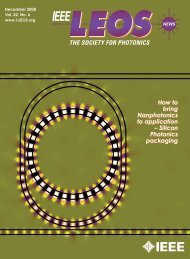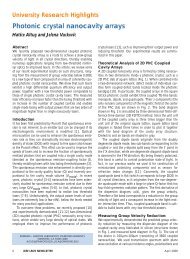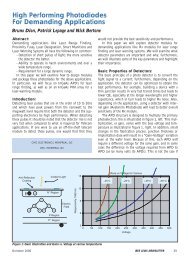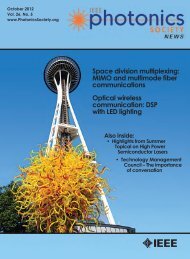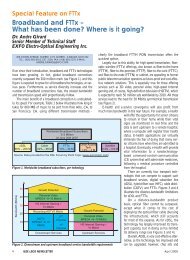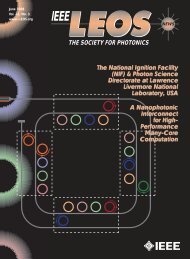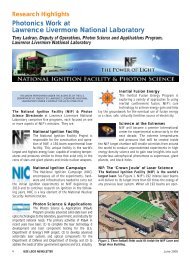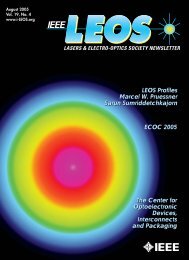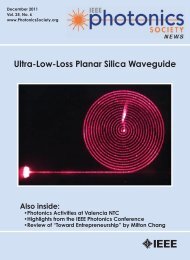Long-Period Fiber Gratings as Band-Rejection Filters
Long-Period Fiber Gratings as Band-Rejection Filters
Long-Period Fiber Gratings as Band-Rejection Filters
Create successful ePaper yourself
Turn your PDF publications into a flip-book with our unique Google optimized e-Paper software.
Principle of Operation<br />
Consider a single-mode fiber with the propagation constant of<br />
the fundamental mode, LP 01 , denoted by β 01 and the propagation<br />
constants of the cladding modes given by β (n)<br />
cl , where<br />
the superscript denotes the order of the mode. The relative<br />
positions of the propagation constants (for a given<br />
ω, ω = ω 1 ) are shown in Figure 1. The hatched region<br />
extending from 0 to n cl ω/c represents the continuum of radiation<br />
modes that exist for an infinite cladding. We restrict this<br />
analysis to a purely rectangular index modulation along the<br />
fiber with the periodic index structure being perpendicular to<br />
the fiber axis. These <strong>as</strong>sumptions exclude blazed gratings and<br />
<strong>as</strong> a result modal overlap conditions dictate that the fundamental<br />
guided mode can couple only to those cladding modes<br />
that are azimuthally symmetric with a central peak at r = 0.<br />
The ordinals of β (n)<br />
cl reflect this <strong>as</strong>sumption.<br />
In order to couple from a forward propagating guided<br />
mode to backward propagating (guided or radiation) modes<br />
the ph<strong>as</strong>e matching K-vector is large, thus requiring a shortperiod<br />
grating. Examples of these gratings are Bragg-reflectors<br />
(for coupling to a back-propagating guided mode, denoted<br />
by −β 01 ) or blazed/tilted gratings (for coupling to backpropagating<br />
radiation modes).<br />
The ph<strong>as</strong>e matching condition between the guided mode<br />
and the forward propagating cladding modes is given by<br />
β 01 − β (n)<br />
cl<br />
= 2π <br />
(1)<br />
fiber at a specific wavelength. We then obtain a set of periodicities<br />
(n) that will meet the ph<strong>as</strong>e-matching condition given<br />
by (1). This step is then repeated for several different wavelengths;<br />
the resulting plot of coupling-wavelength versus<br />
grating-period is shown for an AT&T dispersion-shifted fiber<br />
(DSF) in Figure 2. One can choose a grating period such that<br />
mode coupling takes place at any desired wavelength. Further,<br />
the choice of ’s also allows the designer to vary the separation<br />
between two cladding modes, denoted by δλ.<br />
The AT&T DSF w<strong>as</strong> modeled by using an exact refractive<br />
index profile in the mode-parameter calculation program<br />
developed by Lenahan [10]. The method of solution<br />
involved a finite element approach that reduced Maxwell’s<br />
equations to standard eigenvalue equations and an eigensystem<br />
package (EISPACK) computed the desired propagation<br />
parameters for the guided mode. The cladding mode propagation<br />
constants were calculated using the eigenvalue equa-<br />
Broadband<br />
Source<br />
PC<br />
<strong>Fiber</strong><br />
KrF L<strong>as</strong>er<br />
<strong>Fiber</strong><br />
Optical<br />
Spectrum<br />
Analyzer<br />
Figure 3: Experimental setup for long-period grating fabrication.<br />
AM: Amplitude m<strong>as</strong>k. PC: Polarization controller.<br />
AM<br />
where is the grating periodicity required to couple<br />
the fundamental mode to the nth-cladding mode. In<br />
this c<strong>as</strong>e, the ph<strong>as</strong>e matching vector is short resulting<br />
in a long , typically on the order of hundreds of<br />
microns. For another ω, (ω = ω 2 where ω 2 ω 1 ) one<br />
can visualize the K-vector of the grating coupling the<br />
guided mode to the edge of the radiation mode continuum.<br />
This optical frequency ω cut corresponds to a<br />
minimum wavelength, λ cut , at which the grating can<br />
couple the fundamental mode to the radiation<br />
modes. This parameter is used to describe grating<br />
behavior in the subsequent analysis.<br />
Theory<br />
One can now predict the wavelengths at which<br />
mode-coupling will be enabled by a particular grating<br />
period. The first step in our modeling approach<br />
involves the calculation of the propagation constants<br />
of the guided and the various cladding modes of a




